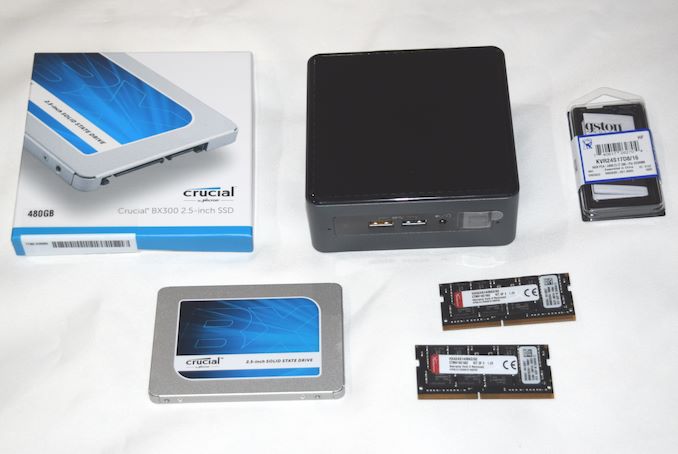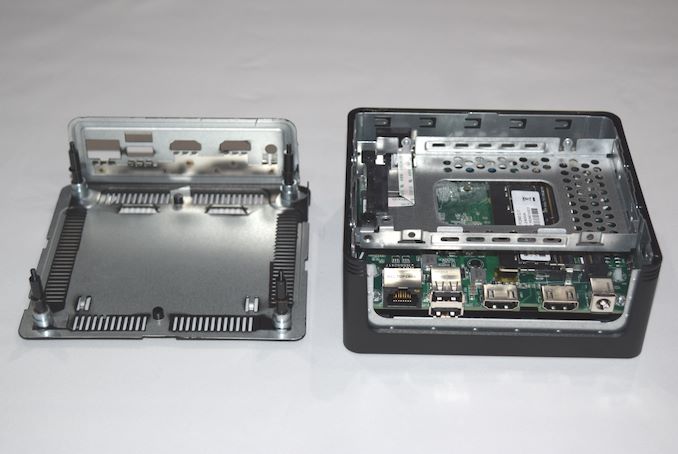Gemini Lake SFF PC Showdown: Intel's June Canyon (NUC7PJYH) and ECS's LIVA Z2 Reviewed
by Ganesh T S on December 20, 2018 8:00 AM ESTConcluding Remarks
Earlier I briefly touched upon the HTPC capabilities of the two Gemini Lake PCs. Of the two, the ECS LIVA Z2 is particularly attractive due to its passively cooled nature. Gemini Lake has one of the most power-efficient and full-featured video decoders in the market - It is capable of even handling VP9 Profile 2 in hardware. The only disappointing aspect from a HTPC viewpoint is that HDR is not supported. Consumers looking for a full-featured HTPC setup have to look beyond Gemini Lake for their needs. That said, if HDR is not a concern (as is likely in most TVs installed in a secondary location), Gemini Lake in general and the ECS LIVA Z2 in particular are good choices to consider.
Moving on to the power consumption aspect, we recorded the maximum sustained at-wall numbers while running the AIDA64 System Stability Test.

These numbers show that Gemini Lake, despite running at the same clocks as Apollo Lake, has managed to provide better performance per watt. The raw numbers are approximately the same when two systems with similar cooling situations are compared.
The Intel June Canyon NUC7PJYH Build Components
Coming to the business end of the review, Gemini Lake has shown itself to be a solid successor to Apollo Lake. Doubling the internal cache has led to significant performance increase in many real-life workloads. This is particularly evident when comparing the performance numbers of the NUC7PJYH (June Canyon) and the older NUC6CAYH (Arches Canyon). In addition to the performance bump, we also have better Wi-Fi capabilities. The product is not perfect, though - the installation of a 2.5" drive is not as easy as it is in some of the other UCFF PCs such as the ECS LIVA Z2. With the rise in popularity of M.2 SSDs, Intel could as well replace the 2.5" drive caddy with a M.2 SATA SSD-only slot on the motherboard, and reduce the system volume. The default fan curves could always use some tweaking, but, that is more of a subjective issue. These are very minor issues.
Accessing the Drive Caddy and the SODIMM Slots in the ECS LIVA Z2
On the other hand, the move from the ECS LIVA Z to the Z2 is a mixed bag. While the all-important fanless nature is still present, the retaining of aspects such as the measly 32GB of eMMC (with Windows 10 Home pre-installed) do not make for a good user experience. 32GB of eMMC may suffice for certain single-purpose industrial application systems, but, as a general-purpose PC, consumers will need to install an additional 2.5" SATA drive (similar to what we had to do for processing this review). Some consumers may appreciate the replacement of the mini-DP port in the LIVA Z with a full-sized HDMI one in the LIVA Z2. However, the sacrifice of a second LAN port for this is not a particularly good trade-off. That said, the performance increase enabled by Gemini Lake still makes the ECS LIVA Z2 a good choice over the ECS LIVA Z for most applications.












59 Comments
View All Comments
mode_13h - Friday, December 21, 2018 - link
Maybe it's still dual-channel, but the speed drops due to difficulty driving the load. In the past, certain Intel CPUs would do things like that.craxity - Friday, December 21, 2018 - link
@LMonty: The NUC works in dual-channel mode (tested 2x16GB, 2x8GB and 2x4GB), but the memory performance is simply low.I'm using a NUC7PJYH since June and already discussed the topic in Intel's forum.
LMonty - Friday, December 21, 2018 - link
@craxity thank you for this info. Could you elaborate pls. on low memory performance? Wouldn't the memory bandwidth be dependent on the RAM speed (e.g. DDR4 2400 with 64-bit controller will result in 2400x8 = 19.2 GB/s single channel, 38.4 GB/s dual channel)?denywinarto - Friday, December 21, 2018 - link
Any words on legacy boot ? I had to sell j4105 that i bought because it lacks legacy bootspeculatrix - Monday, December 31, 2018 - link
I'm not trying to be difficult but UEFI works well on modern Intel motherboards. It's all the crappy older systems, or cheap Chinese tablets, with crappy UEFI implementations that give UEFI a bad name.mode_13h - Friday, December 21, 2018 - link
Thanks for this, but I sure wish you'd have included an i3 NUC (or whatever's the next step up with a performance-optimized core) and like a Pentium Gold G5400 desktop CPU.I'm always curious to know what one is leaving on the table by opting for Intel's power/cost-optimized product line (AKA its Atom-lineage processors).
GreenReaper - Saturday, December 22, 2018 - link
The LIVA Z2 looks to be underperforming, but perhaps not once you consider it's over 40% cheaper, includes an OS, and uses half the power. If you need more you could throw another stick of RAM in. Anything more and I suspect you'd want to step up to a full-fat CPU anyway.eastcoast_pete - Sunday, December 23, 2018 - link
I must say that I am disappointed with both these two "HTPC"s and the review. The review is cookie-cutter type and only just okay if what one want to know are the benchmark numbers shown, but is deficient in key areas. The biggest missing piece is: Are these Home Theater (!) PCs any good for home theater use? The answer (probably not) is buried in the last section in a single sentence: "The only disappointing aspect from a HTPC viewpoint is that HDR is not supported". That's it? In 2018/2019?@Ganesh: please expand on what these NUC-type units can and cannot do when it comes to playing media, and mention severe limitations like "no HDR" in the first paragraph or so! The missing information on these two "HTPC"s reviewed here include the HDMI standard that they feature and what that means (i.e. can they do UHD (4K), at how many frames/second, 8bit or 10bit color output etc.), can the CPU natively decode HEVC/VP9 etc. at what frame rate especially for UHD, how is the playback quality, is there tearing or stuttering etc. An actual test or two of decoding/playback capabilities might be important in an HTPC (!) review, don't you think? Lastly, information on the audio out (channels, connectivity, distortion..?) is similarly MIA.
For me, the summary for the two NUCs or NUCalikes reviewed here is: Nice, compact mini-computers for light computing and office use, but not suitable for use as a home theater PC as we approach 2019. As of now, UHD with HDR comes standard with essentially all new TVs, including almost all entry-level models (try to find a model year 2018/2019 TV set without those). A new HTPC that cannot even utilize those minimum capabilities is obsolete the moment it's purchased.
eastcoast_pete - Sunday, December 23, 2018 - link
@Ganesh To clarify: I know you didn't call them HTPCs in the title, but that is what many (most?) users are or will be considering these NUCs and NUCalikes for. Almost anybody I know bought their NUC for use as an HTPC, and that is where these Gemini Lake NUCs fall flat. It can get frustrating to have to tell people over and over "Yes, this NUC is cheaper. No, it will not give you the HTPC experience you're looking for". So, even if you haven't run the media playback tests on these and can't add the information, a stronger "buyer beware" and what to consider instead is in order. Intel made sure that Gemini Lake systems cannot provide the multimedia experience that a 2018/2019 HTPC should provide; for that, one has to buy a core-based NUC.silverblue - Sunday, December 23, 2018 - link
To be fair, I can't remember the last time I saw HTPC benchmarks, maybe it was back during the Kaveri era.